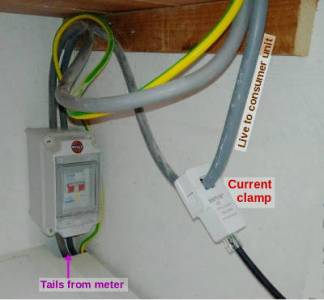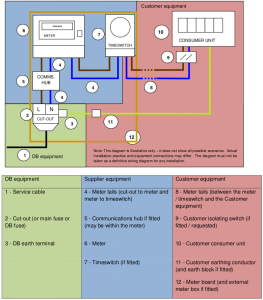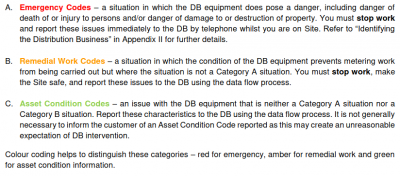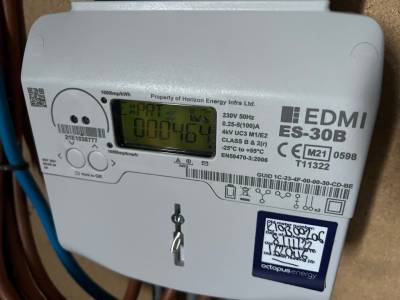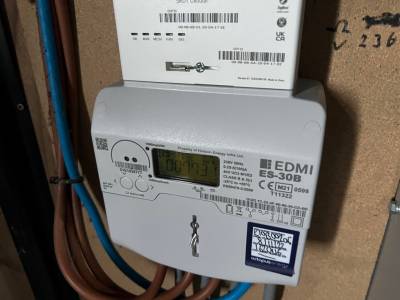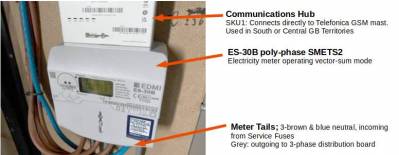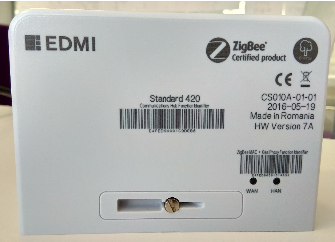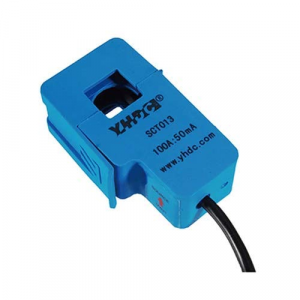The installation of a Smart Meter provides a good opportunity to have an additional 2-pole isolation switch between the meter and the consumer unit.
This is effectively just a 100A AC breaker, identical to the Mains Switch already in the Consumer Unit (aka Distribution Board).
It's held within its own DIN-rail enclosure, which must have sufficient physical space to allow easy connection of the 25sq.mm 'meter tails'
A separate isolation switch such as this allows an electrician to work within the consumer unit at a later date without having to ask the DNO to 'pull the Service Fuse".
Some Energy Suppliers will offer to have their meter engineer install an isolation switch then they fit the meter.
They will bill you separately for this work.
Alternatively you can employ a local electrician to install the isolation switch in advance of the Smart Meter being installed.
It is then ready to receive the new meter tails (double-insulated cables).
An isolation switch may not be mounted onto the same back-board as the Smart Meter and Service Fuse, although this is commonly done!
That back-board is reserved for equipment which is owned by statutory 3rd party organisations such as your DNO, Energy Supplier and DCC.
Save energy... recycle electrons!
The Smart Meter installation process has been developed to double-up as a safety-check.
The trained installation engineer operates under the Meter Operation Code of Practice Agreement (MOCOPA) between Energy Suppliers and the Electrical Networks Association.
Before the meter installation commences, the mains supply to the property is subjected to a visual inspection.
There are a number of possible deficiencies, divided into three Asset Condition Codes
These are more fully described within Annex 1.7 of the MOCOPA Guide, version 3.5, which contains excellent colour photographs to illustrate each possible fault.
You don't need to be a qualified electrician or a MOCOPA-trained engineer to report faults listed in the Guide.
Anyone who finds a mains-incomer which appears to fail one of these visual checks can report the situation to the regional DNO.
Ideally, send them a photo. That enables them to prioritise their response.
The MOCOPA Guide is within a large tranche of documents which have been allocated to the Retail Energy Code Company (RECC).
They are busy rewriting all such documents into a common format.
The 'new' Smart Meter Installation Schedule reads like a set of legal definitions, allocating responsibilities.
It is functionally useless as it omits all the tables and graphics!
I strongly recommend that you download a copy of the earlier v3.5 of the MOCOPA Guide for future reference.
You never know when it will be 'found' by RECC and deleted from the site which I've linked to!
Save energy... recycle electrons!
Ok - I've got a quite an experience, now being investigated by the Energy Ombudsman. I switched to Octopus to benefit from their Outgoing Octopus tariffs for exports. They installed a new import/export Smart Meter in November and, suddenly, our import readings went way up. We brought it to their attention and they agreed that the readings were not in accordance with our historical data, and said that they would investigate the possible 'meter discrepancy'. That was in early December.
Since that time, Octopus failed to communicate about this even with me making dozens of phone calls and sending dozens of emails, always receiving the promise that someone would get back to me 'in a day or two'. When I finally told them I'd complain to the Energy Ombudsman, they sent out an engineer to check the meter - but the engineer was not qualified to deal with 3-phase meters, which is what Octopus installed.
When I heard nothing more from Octopus and complained about the fact that they failed to send another engineer, they responded by saying that now they don't think there is a meter discrepancy (they sent me some calculations that they made more or less on the back of an envelope), but they would send another engineer who can handle 3-phrase. In the SAME email they also suggested that I hire an electrician to figure out if the meter discrepancy exists - if it does, they would reimburse the cost (yeah, I really trust that one! BTW, I asked my electrician whether he could do this, and he said that he couldn't as it requires specialised equipment). So, I filed my complaint with the Energy Ombudsman - it's been more than a month since I've heard from Octopus at all, and the Ombudsman reviewed the complaint and is now investigating it with Octopus.
So, whatever the experience with Smart Meter installation, know this: if anything goes wrong in the process you can expect that Octopus won't help you.
A footnote: we have installed electricity meters to measure the electricity use of the Ground Source Heat Pump and our borehole pump so that we can get a better idea about what percent of our imports comes from our heating system. We also have 100 solar panels and check the exports versus generation each day so, finally, we are getting a handle on total generation versus total consumption. We measure this against daily minimum temperatures. It still doesn't tell us whether the Smart Meter is working properly, but at least we can see whether the fluctuations in imports correspond to the energy use of our heating/hot water system.
That's a sorry tale @phowardstutterheim
It should not have been the case that Octopus failed to treat as a complaint your statement in December that there was a "meter discrepancy".
Nor should you have communicated so often by phone and email.
1: There are only two stages in Octopus Complaints Procedure before the issue can be taken to the Office of the Energy Ombudsman as Stage-3.
If you report the matter by email on each of those two initial stages, then you have a date/time-stamped document.
Those emails on their own are sufficient for the Ombudsman to accept the case after 8-weeks has elapsed.
2: Several of us here this Forum could advise you a number of methods by which you could check the accuracy of the Smart Meter.
Requesting an electrician to do so isn't the best option.
You really want a monitoring device which remains in the house over several days (or even weeks).
An electrician would really only be able to check your usage over a relatively short period of time whilst he's on site. That approach is prone to measurement errors.
3: All electricity meter readings are logged with ECOES, the central meter database.
That's one way in which meter fraud can be detected.
The usage can be compared over many months of use, both before and after a new meter has been installed.
ECOES data isn't available to us as consumers, but it's certainly a source of evidence which can be checked by an Energy Supplier, such as Octopus.
That it hasn't been consulted, is indicative that your case was being handled by an ordinary member of the Customer Services Dept, rather than a specialist complaints-handling officer, as stated in their Complaints Procedure.
4: As Smart Meter issues are uncommon, it's unlikely that consumers understand what they can do.
You need rapid access to those of us who understand the background technical issues (& the complaints process!).
Please advise anyone else in a similar situation to use a forum like this.
Finally, as 3-phase domestic Smart Meters are so rare, can we have a photo please! 🙂
Save energy... recycle electrons!
Thanks for your very informative missive! I'm curious as to the monitoring device that you mention - but I presume it is not available to consumers? We had an interesting situation, aside from the increase in imports - which is that, for more than two weeks, our heating system (GSHP) was completely down, but energy usage remained about the same. This may have been (party) due to the fact that a) our hot water had to be produced 100% electrically, and b) we were using a few small space heaters to try to keep warm. Otherwise, we were rather agast at this. We followed the Ombudsman procedure in full, providing all the documentation that you mention.
I'm posting photos of the 3-phase Smart Meter, as requested.
You could hire and attach a power analyser similar to the one below, or maybe you could encourage Octopus to install one for a period of time to check your present 3 phase meter.
If you have to do so yourself then one could be hired from the company detailed below.
@phowardstutterheim, did you lodge the complaint with UtilitiesADR? I’ll be curious to see how they rule, because they were our ombudsman for a solar PV complaint and they ruled in the installer’s favour (E.ON) stating that we needed to prove that E.ON hadn’t overcharged us for equipment we never received - failing to hack E.ON’s accounting system, I’m not sure how we could prove it.
I hope that your complaint goes smoothly though.
Get a copy of The Ultimate Guide to Heat Pumps
Subscribe and follow our YouTube channel!
Thanks for the photo @phowardstutterheim and let me add some labels to assist others reading this in future:
The Comms Hub is exactly the same as would be used for a single-phase site.
The row of five LED indicators tells us that the site is in the Southern or Central GB territories, for which the Smart Meter Network licence is held by Telefonica.
In the Northern territory, which includes Scotland, the Comms Hub has just two LEDs which can flash either red or green.
However, the Electricity Smart Meter Equipment (ESME) shown above is physically larger than the usual single-phase device.
The internal electronics circuity is little different, but the enclosure has to accommodate three 100A relays and eight large brass terminals at the base.
A Poly-phase ESME can operate with a 3-phase supply (as in this case), and also 2-phase, split-phase or two separate supplies that are phase independent.
It uses Vector-Sum metering which handles import and export separately across the phases.
If the site has solar-panels, with a single-phase inverter connected to just one of the phases, the customer is only billed for the difference in consumption across those phases.
Ie you don't receive export credits for what goes out on one-phase, whilst simultaneously buying back in at a much higher price on the other phases.
Unlike commercial sites, a domestic property won't be using the three phases evenly.
Most appliances are still running on 240vAC (single-phase).
It usually just a heat-pump and/or EV charger which operate as a 3-phase device.
For this reason, the Neutral won't 'rest' at zero-volts.
It will inevitably be carrying some current which must also be accounted for.
Save energy... recycle electrons!
Posted by: @editorour current metre is in the back of a kitchen cupboard and access to it is not great.
Do you mean that you built the kitchen around it?
Assuming that it's not too cramped in the cupboard you should be OK. In my daughter's case they had to organise a repositioning of the DNO fuse to make space (it was in a small cupboard in the entrance hall along with the consumer unit). Consequently, several visits by several people.
Posted by: @derek-mYou could hire and attach a power analyser similar to the one below
And there are also options to assemble one yourself using an Arduino micro-controller.
If would make a great technology project for a student at A-level or 1st-degree standard 😀
There are other alternatives using energy meters and split current-transformers bought directly from suppliers in China.
An energy-meter certified as 'MID' is regarded as being suitably accurate for billing purposes.
A split-core current transformer can be clipped around a wire without cutting into it.
It's called a non-invasive measuring device.
Save energy... recycle electrons!
- 26 Forums
- 2,372 Topics
- 53.8 K Posts
- 250 Online
- 6,053 Members
Join Us!
Worth Watching
Latest Posts
-
RE: Testing new controls/monitoring for Midea Clone ASHP
Thanks all for the suggestions. Might help if I try a...
By benson , 8 seconds ago
-

RE: New Fogstar 15.5kWh upright solution
Running the power-leads in parallel is OK,but not so fo...
By Transparent , 3 minutes ago
-

RE: Forum updates, announcements & issues
@dr_dongle There is no such thing as ‘Too Much Informat...
By Toodles , 13 minutes ago
-
Weather compensation- why you should use it
Brief update on weather compensation (AI). I have a LG ...
By Tim441 , 18 minutes ago
-

RE: Data Accuracy Problem: Daikin 8kW Heat Pump's Onecta App vs MMI Power Consumption
@nursethescreens Yes, comfort and happiness of the fami...
By Toodles , 21 minutes ago
-

RE: Solar Power Output – Let’s Compare Generation Figures
@tim441 I have just realised that I omitted the Decembe...
By Toodles , 27 minutes ago
-
RE: Connecting Growatt SPH5000 over wired ethernet rather than wireless
Thanks folks. I had tried googling an ethernet lab adap...
By z8lccda , 15 hours ago
-
RE: Changing from 4-port buffer to volumizer
@toodles I'm not concerned that the behaviour is not no...
By Andy1618 , 15 hours ago
-

-

RE: Setback savings - fact or fiction?
I agree, and I think there are two things in play here....
By cathodeRay , 20 hours ago
-
RE: Water Hammer After Heat Pump Install
That's really helpful. Yor last sentence confirms it'...
By JamesPa , 1 day ago
-
RE: Help needed with Grant Aerona 3 issues
First time posting so bear with me. Some bits that have...
By Adamp , 2 days ago
-
RE: Mitsu PUHZ-SW120YHA + EHSC-VM20Uk - Performance
All understood. Obviously its a bit house de...
By JamesPa , 2 days ago
-
RE: Who's your electricity provider and what's your tariff?
@majordennisbloodnok This may be a better thread to ...
By Batpred , 3 days ago
-

RE: Best Heat Pump Brand in the UK
Last Call to Vote & Win! Haven't voted for your Hea...
By Mars , 3 days ago
-

RE: Solis S6-EH1P8K-L-PLUS – Why I Chose It and What I’ve Learned So Far
Interesting question. To be frank, since I have no inte...
By Majordennisbloodnok , 3 days ago
-
RE: Ecodan unable to hit legionella target temp - what's the consensus?
@9jwr9 Hi, yes this is the issue with every (stand alon...
By ASHP-BOBBA , 4 days ago
-
RE: Help me keep the faith with my air source heat pump installation
@adamk FWIW I managed unintentionally to 'coax' mine in...
By JamesPa , 4 days ago
-
RE: Octopus Cosy Heat Pump Owners & Discussion Thread
You are in essence right. Adia only works with selecte...
By JamesPa , 4 days ago

